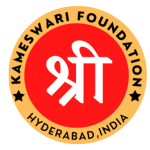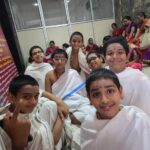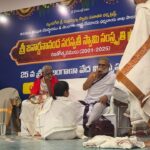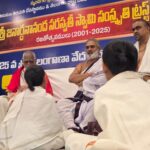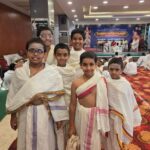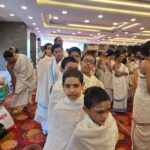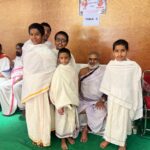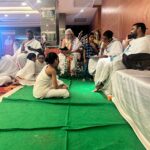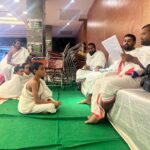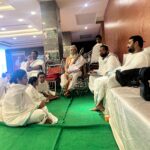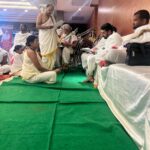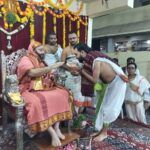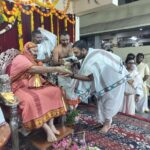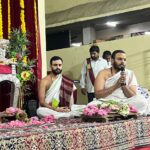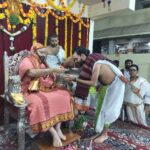
Monthly Highlights – October 25
- Posted by Sri Kameswari Foundation
- Date November 9, 2025
- Comments 0 comment
Greetings Everyone!!!
The month of October has been filled with enriching experiences – interactions with Vedic scholars,seekers and blissful beings(our revered Gurus),whose very presence brings anirvachaniya ananda(indescribable joy).
The warmth and encouragement we receive from Gurus and seekers for the authentic content we strive to present on every occasion give us renewed energy and confidence to continue the work we believe will shape future generations.
The month began with Shakti Puja (Dasara),filling our hearts with divine energy and continued with the celebration of Deepavali,reminding us to connect with the inner light and engage in sadhana during the sacred Karthika Masa — an auspicious time to draw closer to the Supreme Self.
We are delighted to share that our activities throughout this month have beautifully aligned with these spiritual reflections which are detailed in this newsletter.
Highlights of OCTOBER 2025
1.Sri Kameswari VedaPathashala Students Excel in the VedaPariksha conducted at 25th SriTelangana VedaVidwan Mahasabhas
As part of the 25th SriTelangana VedaVidwan Mahasabhas organized by SriJanardanananda Saraswati Swami Samsmruti Trust,our students from SriKameswari VedaPathashala appeared for the examinations in the Brahmana and Aranyaka portions of the KrishnaYajurveda and passed the examinations successfully.
The examiners were deeply pleased with the students performance and blessed them abundantly for their excellence.
We express our heartfelt gratitude to our revered Acharya,Kunapuli Ganesh Karthikeya Ghanapathi garu,who is moulding our children into radiant,wise and devoted seekers — scholars
We also offer our salutations to Guntur Revanth Ghanapathi garu,who conducts monthly tests for the students and trains them to face examinations with confidence and competence.
Congratulations to our young learners,who,while upholding this traditional Vedic education,are studying with dedication to preserve it in its pristine form.
At our Pathashala,students not only study the Vedas,but also learn Kalaripayattu to enhance physical and intellectual strength,and pursue age-appropriate academic subjects,participating in respective NIOS examinations as well.
In spite of several challenges,our institution continues its activities uninterrupted,thanks to the dedication of our co-founder,Dr.Jammalamadaka Suryanarayana garu and his wife Smt.Pravallika garu,to whom we convey our special gratitude.We sincerely pray that Kameswari ammavaru continues to shower Her divine grace upon them,empowering them to translate her noble intentions into action.
We offer our respectful salutations to the SriJanardanananda Saraswati Swami Samsmruti Trust for organizing the VedaVidwan MahaSabhas and examinations so magnificently.
Finally,we bow to all our Gurus, elders, and Dharma practitioners, who continually bless and encourage us in our journey.
2.Blessed by revered Gurus at Dasara Darbar,Pushpagiri Mutt– 02-10-25
Dr.J.Suryanarayana garu and Dr.J.Srinivas garu participated in the Dasara Darbar at Pushpagiri Mutt,a historic seat of learning dating back to the 13th century.
In the divine presence of Sri Sri Jagadguru Vidya Shankara Bharati Swamiji, they presented illuminating insights from the Shastras. The experience was deeply humbling,and the grandeur of the Dasara Darbar added to the spiritual and intellectual depth of the occasion.
3.Talk By Dr.J.Suryanarayana garu on the refutations made by SriHarsha regarding certain definitions in TarkaShastra
Do you think all the works composed by our Maharshis and Acharyas were accepted as they are by our previous generations?
The answer is a well-known “No.” There are numerous examples of this — not only at the academic level but even within the scriptures themselves.
This marks a fundamental difference between Sanatana Dharma and other belief systems. In many external faiths, followers are not permitted to question or disagree with their religious texts, irrespective of the circumstances.
However, the beauty of this eternal dharma lies in the freedom it grants — the liberty to express one’s understanding and perspective on any concept revealed across the expanse of this creation.
When such freedom to disagree exists, it naturally raises a question — what should be the true objective of refutation?
Is it appropriate to oppose something merely out of personal opinion, or should there be a guiding principle behind such disagreement?
When we examine our knowledge systems, we see that every vidya — whether para or apara — ultimately aims at moksha,the supreme goal of human life.
Therefore,the essential purpose of any refutation must be to reveal the ultimate truth — Advaita or non-dual reality. uch acts of refutation,when aligned with truth,neither bind us nor lead to future births.
Those who ignore this fundamental principle may succeed for a while through their debating skills, but eventually, their arguments will be refuted by valid reasoning, and they will have to face the karma arising from not aligning with the true purpose of vidya.
In this context,we bring to you a talk by Dr.J.Suryanarayana garu,focusing on the refutations made by SriHarsha regarding certain definitions in TarkaShastra.
This talk elaborates on the objective of refutation introduces the concept of definition in Tarka Shastra, and discusses SriHarsha’s refutation of the definition of Dravya (substance).
Note: Please take some time — perhaps listen to it a couple of times — to truly grasp the purpose of this work and appreciate the depth of logic, the profound understanding of creation, and the refined method of refuting siddhantas (theories).This approach is especially vital in our times,where progress is often built upon pre-established theories, theorems, and axioms — that are rarely revisited or questioned in the rush of a fast-moving world.
If the followers of this dharma do not take time now to question thoughtfully and redefine according to changing times,we may risk losing the authenticity of our sacred works in the years to come.
We thank Indic Academy for hosting this talk series that reinforces the pursuit of truth grounded in non-dual reality.
4.“Aham Brahmasmi” — We know the meaning, but what about the experience? – Discourse By Dr.J.Srinivas garu – 22-10-25
In the present times, with the blessings of our Gurus, we have gained some understanding of Vedantic subjects such as the Jiva (individual soul), Deha (body), Parabrahman (Supreme Reality), Jnanendriyas (organs of knowledge), Karmendriyas (organs of action), Manas (mind), the three states of consciousness, and Prarabdha (karma in operation).
The four Vedas declare through the four Mahavakyas that there is no real difference between the Jiva and Parabrahman — “Prajnanam Brahma,” “Aham Brahmasmi,” “Tattvamasi,” and “Ayamatma Brahma.”
We may intellectually understand their meaning to some extent, yet the ultimate goal of human life as proclaimed in Sanatana Dharma — Moksha (liberation) — can be attained only when these truths are realized through direct experience.
And that is the real challenge!
In worldly life, if we write what we have learned, we pass an examination. But for Paramarthika Moksha (spiritual liberation), that is not enough. True success lies in becoming what we have known — in transforming knowledge into being. This is a profound and deeply contemplative subject.
Explaining such a complex concept — what it truly means to experience the Mahavakya “Aham Brahmasmi” — in a simple and systematic way that even children and adults alike understand,our Acharya – Dr.Jammalamadaka Srinivas garu delivered a discourse at the Sri Sathya Sai Study Circle, Shivam, Hyderabad.
He presented Vedantic ideas in a wonderfully relevant manner for the present times, clearly illustrating — through vivid examples — the difference between Western and Indian modes of thought.
We express our heartfelt gratitude to Sri Sathya Sai Study Circle for providing this noble opportunity.
5.Shastra Sabha at Shankara Math,Nallakunta,Hyderabad – An Inquiry into Types Of Debate by Dr.Jammalamadaka Suryanarayana garu – 23-10-25
A Shastra Sabha is an assembly of scholars who have deeply studied the Shastras. It is a sacred gathering where they collectively deliberate upon specific subjects from the scriptures, engaging in thoughtful discussion and intellectual inquiry.
On the 23rd of this month, as part of the Telangana Dharma Vijaya Yatra,a Shastra Sabha was held at Shankara Math,Nallakunta,Hyderabad,under the divine guidance of Jagadguru SriSriSri Vidushekhara Bharati Swamiji.
Observing this Sabha enables one to understand vividly why such assemblies are conducted, what happens within them, and how they are organized.
In today’s times,when we often turn towards Artificial Intelligence for answers to every question,this Sabha served as a reminder that the questions pertaining to our ancient Indian intellectual traditions cannot always find their truth in the responses generated by machines.
During the discussion on Vyakarana (Sanskrit grammar), scholars deliberated for nearly an hour and a half on the proper interpretation of the sentence “Devadattaḥ taṇḍulam pachati”.
Listening to this discussion offered deep insights into how a single word in Sanskrit can carry multiple shades of meaning, how precise definitions are derived, and how carefully one must approach the interpretation of each Shastric statement.When words themselves are layered with such complexity, understanding their contextual meanings in each discipline becomes a sacred and meticulous process.
Such Sabhas are noble efforts by learned scholars to preserve and safeguard the inherited wisdom of our tradition,ensuring that the continuum of knowledge passed down through generations remains free from distortion.
When such an assembly takes place in the divine presence of the Jagadguru, it is indeed as though one has received the very approval of the Divine Mother herself, the embodiment of Mahavidya — the Supreme Knowledge.
For the general public,these Sabhas serve as windows into the vast expanse of Indian intellectual heritage. They introduce us to the diversity and depth of the Shastras and help us appreciate the precision with which our Rishis transmitted these disciplines without compromising their essence.
Even without complete proficiency in Sanskrit, anyone with command over their mother tongue can understand much of what is being discussed — for being born in this sacred land itself grants one a natural connection to its wisdom.
We often hear that Shastra means “that which instructs” — that which lays down how, when, and in what manner a thing should be done.
To truly understand why Shastra is considered the ultimate authority and the grandeur of its principles, one must witness the intellectual rigor and respectful debate that unfold in these Sabhas.
In ancient times, kings sought the guidance of Acharyas — to ensure the prosperity of their kingdoms, to overcome enemies, and to understand the ultimate goal of human life.
By observing the nature of discussions in such Sabhas, one realizes why rulers of the past turned to spiritual and philosophical wisdom for counsel and also gains a glimpse of the splendor of the Shastras.
If we can witness such Shastra Sabhas ourselves and also introduce them to our children, inspiring in them a love for scriptural knowledge, we would be fulfilling our duty of nurturing worthy heirs to our Dharma.
As part of the Telangana Dharma Vijaya Yatra,it was indeed a divine blessing that our Acharyas — Dr.Jammalamadaka Suryanarayana garu and Dr.Jammalamadaka Srinivas garu — participated in the Shastra Sabha held under the guidance of Jagadguru SriSriSri Vidushekhara Bharati Swamiji.
The video shared here presents the discussions of Dr.Jammalamadaka Suryanarayana garu,an eminent scholar of Nyaya and Vedanta, during the Sabha.
He elaborated, with insightful examples, on the fundamental concepts of Vada (forms of reasoning) in Nyaya Shastra —
- What is Jalpa (a contentious or quarrelsome debate)?
- Under what circumstances does a discussion become Jalpa?
- What are the different types of Chhala (fallacies or deceptive arguments)?
- What distinguishes one type from another?
Understanding these principles helps us discern the intent and nature of those who engage in debate with us.
During the discourse, Jagadguru SriSriSri Vidushekhara Bharati Swamiji beautifully referenced the examples used by Adi Sankaracharya during his debate with Mandana Mishra, making the moment a true feast for the eyes and soul.
When we read about the events described in Sankara Vijayam, it is often difficult to imagine how Adi Shankaracharya might have spoken or explained profound ideas.
But this Sabha offered a glimpse of that very atmosphere — allowing the audience to feel and rejoice in the living tradition of philosophical dialogue.
To speak in the presence of the Jagadguru is, indeed, like speaking before Bhagavan Sankara himself,blessed by the grace of Goddess Sarada.
Such a sacred fortune, we believe, is a result of the grace of Goddess Kameswari, whose cool, wide, and compassionate glance — “dṛśā drāghī yasyā dara-daḷita nīlotpala rucā” — bestows divine blessings wherever we are.
With deep reverence and devotion, we offer our humble salutations at the holy feet (Sricharanas) of the Jagadguru, who graciously granted us this divine opportunity.
6.Shastra Sabha at Shankara Math, Nallakunta, Hyderabad – Vedanta Discourse by Dr.Jammalamadaka Srinivas garu – 23-10-25
Vedanta Discussion — Irrespective of how much one brings Vedanta into practical life, it has today become a subject that draws the interest of almost everyone.
The main reason for this is that the subjects discussed in Vedanta are essentially about ourselves.From the young to the old, people eagerly express their views on its concepts with enthusiasm and curiosity.
Shruti (the Vedas and Upanishads) forms the authoritative basis for Vedantic thought, the Smritis, Puranas, and the Prasthanatrayam that follow have elaborated on those truths in depth, enabling us to understand the essence of the Shrutis more clearly.
If one tries to grasp Vedantic principles merely through dictionary meanings, one cannot comprehend them in the manner realized by the Rishis. Instead, one is likely to get caught in the web of doubts and confusions. Only by studying the Vedas, Upanishads, Brahma Sutras, and great teachings such as the Bhagavad Gita collectively and understanding their inner unity can we begin to perceive the Truth that the seers themselves experienced.
This spirit of discussion is what we witness in traditional Shastra Sabhas. As part of the Telangana Dharma Vijaya Yatra conducted under the guidance of Jagadguru Sri Sri Sri Vidushekhara Bharati Swamiji, the Peethadhipati of Sringeri Sharada Peetham, a Shastra Sabha was held in which Acharya Dr.Jammalamadaka Srinivas garu presented an insightful exposition on the “Pranotpatti Adhikaranam” from the Brahma Sutras, addressing the central question — “Is Prana Mukhya(the Supreme) or Gauna (Secondary)?”
Prana is generally understood as that which, through the five vital airs (Pancha Vayus), sustains the existence of the human body.
The discussion in the shastra sabha began by examining what the Shatapatha Brahmana states regarding whether Prana is Mukhya — that is, identical with Brahman — or Gauna — a derivative entity like the senses that originate from Brahman. The discourse also drew upon authoritative references from the Brihadaranyaka Upanishad,Chandogya Upanishad and others to explore this subtle question.
Several learned scholars present in the assembly participated actively in the discussion. The Jagadguru keenly listened to the various viewpoints, harmonizing them with deep insight. The discourse that unfolded was not only nectar to the ears but also a delight to the eyes and the intellect.
The discussion beautifully highlighted the importance of shabda-prayoga — the precise and meaningful use of sound and expression in Sanskrit literature. It was an enriching experience, offering joy and fulfillment to all who could relish its depth.
We offer our respectful salutations, with body, speech, and mind, to the Jagadguru of Sharada Peetham for bestowing this great opportunity for such a profound and elevating exchange of knowledge.
7.EK Spiritual Services – Medical Camp – 12-10-25
Dr.Gopal Rao garu and his committed team efficiently organized a comprehensive Homeopathy Medical Camp at the Abhayanjaneya Swamy Temple,RTC Colony.
The camp catered to students, parents, and local residents, offering valuable medical assistance and relief to those with chronic health conditions.
The Foundation was honored to be part of this community-centered initiative and sincerely thanks Dr.Gopal Rao garu for travelling a long distance despite his busy days.
8.Srimadbhagavadgita Tattvamu – Discourse series by Dr.J.Suryanarayana garu
Continuing our exploration of the Smriti Prasthanam — SrimadBhagavadGita, under the guidance of our Acharya,Dr.Jammalamadaka Suryanarayana garu,we now proceed further into the second chapter — Sankhya Yoga.
In this chapter,Bhagavan SriKrishna imparts the profound knowledge of the Ultimate Truth — the wisdom every soul must realize, which is indeed the very purpose of human birth.
We have now released two new episodes continuing this discourse on our YouTube channel. The English translations of these episodes are available on our website through the Srimad Bhagavad Gita Tattvamu page.
Episode – 7:
How To Experience the Atman,Different levels of reality –
https://kameswari.org/how-to-experience-the-all-pervading-atmandifferent-levels-of-reality/
Ch-2 | Meaning of Shlokas 13-14 – https://kameswari.org/ch-2meaning-of-shlokas-13-14/
Episode – 8:
Pratyabhijna,The Deeper Meaning of “Antaha”,AtmaTattvam – https://kameswari.org/pratyabhijnathe-deeper-meaning-of-antahaatma-tattvam/
Ch-2 | Meaning of Shlokas 15-17 – https://kameswari.org/ch-2meaning-of-shlokas-15-17/
Please visit the below Śrīmadbhagavadgītā Tattvamu page on our website to read the summary of all Episodes in English – https://kameswari.org/srimadbhagavadgita-tattvamu/
9.Tarkasangraha Tutorial Video Series By Chi.Kalaga Achyut Sarma
In traditional Gurukulas and the realm of Shastras, the study of Tarkashastra typically begins with Tarkasangraha, composed by Sri Annambhatta. This concise text, structured in about 300 short sentences, offers a gentle and accessible introduction to the subject.
Kanthasthikarana (committing to memory) of these sentences is highly beneficial — it not only deepens one’s grasp of Tarkashastra, but also enhances the study of other Shastras and cultivates a Tattvika Drishti (philosophical worldview).
With this intent,Sri Kameswari Foundation brings to you the Tarkasangraha Recitation Tutorial, recited by Chi. Kalaga Achyut Sarma. Each sentence is recited twice, enabling learners to repeat and practice effectively.
We have released 2 videos in this series and they can be watched through the below links
You may also like
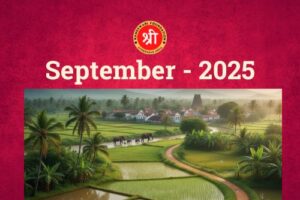
Monthly Highlights – September 25
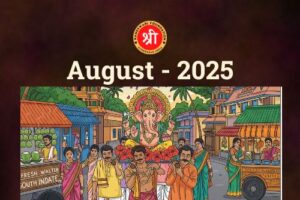
Monthly Highlights – August 25

